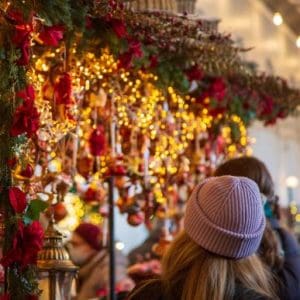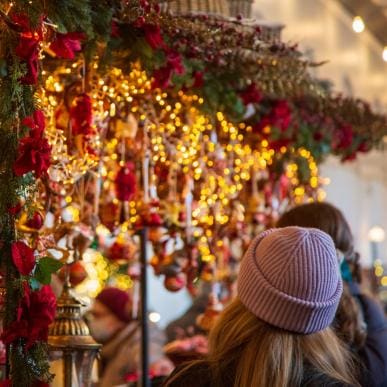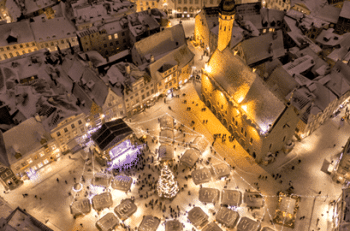For those festive travellers wanting to enjoy a Christmas market in Europe experience that is steeped in fairytale charm, dazzling illuminations, and hygge (a Danish word for feeling content), then look no further than the Copenhagen Christmas markets.
 The charming city has lovely canals, colourful houses and famous landmarks.
The charming city has lovely canals, colourful houses and famous landmarks.
And for Christmas, Copenhagen transforms into a winter wonderland with its collection of interconnected Christmas markets, offering a blend of traditional Danish delights, handcrafted treasures, and a welcoming atmosphere.
The great attraction of Copenhagen’s Christmas markets is that they promise an unforgettable festive escape.
When are the Copenhagen Christmas markets open in 2024?
- Tivoli Christmas market is open between 15 November 2024, to 5 January 2025. (It’s closed on Christmas Eve).
- Højbro Plads Christmas market: November 5 – December 21 2024
- Nyhavn Christmas market: November 4 – December 21 2024
- Julemarked Kongens Nytorv: November 8 to Saturday December 21
- Julemarked Højbro Plads: November 8 to Saturday December 21
Where are Copenhagen’s Christmas markets?
The city boasts several Christmas markets, each adding its own unique touch to the festive spirit. Here are some of the most popular:
 Tivoli Gardens Christmas market: You’ll find this market with its 60 stalls in the attractive Tivoli Gardens amusement park with a great mix of festive cheer, twinkling lights and thrilling rides. There are lots of charming wooden stalls – you’ll need to buy the entry ticket to either get access to the gardens and market or get the one that adds rides.
Tivoli Gardens Christmas market: You’ll find this market with its 60 stalls in the attractive Tivoli Gardens amusement park with a great mix of festive cheer, twinkling lights and thrilling rides. There are lots of charming wooden stalls – you’ll need to buy the entry ticket to either get access to the gardens and market or get the one that adds rides.
Højbro Plads Christmas market: This is a great market in the heart of Copenhagen, and it’s surrounded by historic buildings and the iconic Absalon statue on horseback. It’s known for its traditional Danish Christmas treats and festive atmosphere. This is a picturesque market worth visiting.
- Nyhavn Christmas market: Take a stroll along Nyhavn harbour and its multi-coloured houses and twinkling lights, to explore this charming Christmas market offering local crafts, delicious food stalls and a festive atmosphere.
Other markets worth visiting include Julemarked Kongens Nytorv (King’s New Square Christmas Market), and Julemarked Højbro Plads (High Bridge Square Christmas Market).
These are just a few of the Christmas markets Copenhagen has to offer.
There is a warning though – you might find that the smaller markets begin to close as Christmas Day approaches so be wary about visiting after then to avoid disappointment – check before travelling to ensure that the market you want to visit is being held.
Why visit Copenhagen for its festive markets?
There are lots of reasons to visit Copenhagen and its wonderful markets and not just for the charm of the city – this is one of the friendliest places, we found, to enjoy a festive trip that’s a little bit different.
 Festive Treats: Warm yourself up with a steaming mug of gløgg (mulled wine) infused with cinnamon, cloves and citrus. Indulge in traditional Danish delicacies like æbleskiver (deep-fried apple fritters), pebernødder (spiced pepper nuts), and varm chokolade (hot chocolate) served with a generous dollop of whipped cream. Sample a smørrebrød (open-faced sandwich) piled high with savoury toppings, a perfect lunch option.
Festive Treats: Warm yourself up with a steaming mug of gløgg (mulled wine) infused with cinnamon, cloves and citrus. Indulge in traditional Danish delicacies like æbleskiver (deep-fried apple fritters), pebernødder (spiced pepper nuts), and varm chokolade (hot chocolate) served with a generous dollop of whipped cream. Sample a smørrebrød (open-faced sandwich) piled high with savoury toppings, a perfect lunch option.
- Handcrafted Treasures: Explore a treasure trove of Danish craftsmanship. Find unique Christmas ornaments depicting Danish landmarks like Nyhavn or the Little Mermaid statue, hand-knitted woollen mittens and scarves perfect for the chilly weather, beautifully designed ceramics showcasing traditional Danish patterns, and warm sheepskin throws to bring a touch of hygge home with you. Witness skilled artisans showcasing their expertise in glassblowing, pottery making, and woodworking.
- Festive Entertainment: Immerse yourself in the heart-warming atmosphere with traditional Danish carols sung by local choirs. There are dazzling light displays illuminating the city’s architecture, and the giant Christmas tree at Højbro Plads Christmas market impresses. At Tivoli Gardens you can enjoy festive shows, performances and pantomimes perfect for families.
Copenhagen offers so much more to do than just the markets, including:
- Copenhagen Zoo: There are more than 4,000 animals from around the world – and this is one of the country’s most visited attractions.
- Den Blå Planet – National Aquarium: An impressive aquarium with lots to do.
- SMK – The National Gallery of Denmark: Enjoy Danish art and artists from around the world.
- Amalienborg Palace: Take time to visit the home of the Danish Royal Family.
- Bakken: This might be a mini theme park – but it is the world’s oldest amusement park.
oooOooo
CHRISTMAS Guide to COPENHAGEN, DENMARK
Here’s a great video from Robe Trotting which covers Copenhagen’s Christmas Markets, Danish food, shopping and what to pack for the weather.
He starts with the weather and explains why a warming drink is so popular here when the weather is cold!
Sturdy boots are recommended for visitors – not so much for the cold or being on your feet all day long. No, the presenter highlights that a lot of the city has cobbled streets which might be an issue if you wear trainers, for example. That’s because trainers tend not to offer much support on these surfaces, so sturdy shoes or boots are needed.
Derek the presenter also highlights that Copenhagen is home to several ‘pop-up’ Christmas markets which are worth visiting – if they are being held during your visit.
There’s also a good look at the city’s Christmas magic, including the Christmas markets and Tivoli Gardens – including a recommendation to watch the funny play in English that is held every year.
There’s a quick guide to the best spots for strolling along charming pedestrian shopping streets and an introduction to ‘Julefrokost,’ a traditional Christmas feast. (This could take several hours to complete, apparently).
Copenhagen is home to unique souvenirs and Derek offers recommendations on where to find those unique gifts to impress.
There’s a rundown of the warm drinks and delectable treats that define a Danish Christmas celebration, including liver pate, spiced pepper cookies, and a potentially popular choice with visitors will be aebleskiver, a ‘fluffy Danish pancake ball’ that’s covered with sugar and a dallop of jam. We also get to see beyond the typical tourist spots and delve into the heart of Danish Christmas traditions, creating memories that will last a lifetime.
oooOooo
The tradition of Copenhagen’s Christmas markets
Copenhagen’s Christmas market tradition dates to the early 19th century, originally established as a one-day market for locals to buy provisions for Christmas Eve and the long winter months.
Over time, the markets have evolved into a major tourist attraction while retaining the warm and welcoming spirit.
The market stalls themselves hold historical significance because some have been passed down through generations, adding a touch of authenticity to the city’s Christmas tradition and experience.
Plan a visit to Copenhagen Christmas markets
While we recommend a trip to Copenhagen for the Christmas markets, take note of these Christmas.co.uk tips:
- Planning: It’s a good idea to aim for weekdays, if possible, to avoid weekend crowds, especially at Tivoli Gardens. Book your accommodation well in advance, particularly during peak season.
- Clothing: Copenhagen winters can be chilly, with temperatures hovering around freezing. You should expect snow showers closer to Christmas so pack warm layers – thermals, a winter coat, hat, gloves, and sturdy boots with good grip are essential.
- Currency: Denmark uses the Danish Krone (DKK). In English, most people refer to it as the ‘Danish Crown’. We think exchanging some currency beforehand will be useful since not all the stalls will take cards.
- Souvenirs: Keep an eye out for unique Danish keepsakes such as hand-blown glass ornament of a Danish Viking ship or the iconic Tivoli Gardens entrance.
- Language: It helps to have a few phrases so use these: ‘Goddag’ (Hello), ‘Tak’ (Thank you), ‘Undskyld’ (Excuse me), ‘Hvor meget koster det?’ (How much does this cost?) and ‘Glædelig Jul’ (Merry Christmas).
- Public transport: We found that Copenhagen has an excellent public transport system – clean and regular. This is where the Copenhagen Card comes in. This offers free access to some attractions. There are two cards available: Discover is for all public transport, while Hop includes travel on the city’s ‘Hop on – Hop off’ buses.
While in Copenhagen, take time to sample local produce such as Lakrids (liquorice) sweets, a Danish speciality – said to be the best in the world – that comes in a range of flavours, such as coffee, cinnamon, chocolate and caramel.
This is also the time to invest in a warm and stylish knitted sweater or hat made from Danish wool, perfect for keeping cosy during the winter months.
oooOooo
CHRISTMAS IN COPENHAGEN
Here’s a virtual tour from Happy to Wander for anyone who wants to see what Copenhagen’s Christmas markets are really like.
The first tip is to visit Tivoli Gardens with its rides and stalls. The lights are impressive. The big tip here is to stay until late when things are quieter. The site closes at 10pm but, apparently, people leave before 9pm so the queues for rides are very much shorter.
Nytorv market is worth a trip too with some very nice-looking food offerings.
Hojbro Plads is recommended because it resembles traditional German Christmas markets but with a Danish slant. There are nice gift stalls and food you would expect to find in other European markets.
The presenter says the markets here are better known for their atmosphere rather than the offerings, though some of the designer and craft markets really do stand out.
There’s a trip to the harbour for the Nyhavn market which is colourful and relaxed. There are more pop-up stalls and more bars here – though prices for drinks do vary (a lot)!
There’s even a run-down of hygge attractions for food and drink.
There are several skating rinks to enjoy, and the shop displays also help boost the festive atmosphere.
oooOooo
How to get to Copenhagen for Christmas
- Flying: Copenhagen’s Christmas markets are from the middle of November, and most will finish by the end of December. It is easy to fly directly from the UK to Copenhagen during this time and these airports offer direct flights: Gatwick, Stansted, Heathrow, Bristol, Manchester, Newcastle, Newquay, and Aberdeen Airport. The carriers include British Airways, Norwegian Air International, Ryanair, Scandinavian Airlines and easyJet. The flights take just under two hours. The cost of flights varies on the time of booking, the airline, and the departure airport but we found that Kayak offered a flight to Copenhagen for £120 – the cheapest price was £13 from Stansted Airport. It’s always worth searching for bargain flights!
- Train: For a scenic journey, consider taking the train from London to Amsterdam and then connecting to Copenhagen. The journey can take anywhere between 14 and 24 hours. We found Rail Europe was offering tickets for £76 (the most expensive was £230) for a trip that would take 22 hours.
- Drive: If you fancy a lengthy but fun adventure, then consider driving. The trip of 1,000 to 1,200 miles will take around 18-22 hours – not including stops for food, rest and border crossings. The most common route is to take a ferry from Dover to Calais, and then drive through Belgium, Netherlands and Germany before crossing into Denmark.
- Coach: Another option, which is usually cheaper, is to travel by coach. There are various start points in the UK, including Edinburgh, Birmingham and Manchester and prices are around £45. Though the journey can take up to 32 hours.
Staying in Copenhagen
Copenhagen offers a variety of accommodation options, from charming boutique hotels in the city centre to cosy guesthouses and Airbnbs. We used Booking.com but here are some options to consider:
- Budget hotels: Copenhagen Downtown Hostel is well-located and great for solo travellers; Cabinn Hotels are a great choice for budget travellers with clean and comfortable rooms – prices start from £50 per night; Generator Copenhagen is a hostel with dorm beds and private rooms from £40 per night for a dorm bed and there’s Wakeup Copenhagen which is clean and basic in central locations. Prices start from £60 per night.
- Mid-range hotels: Copenhagen Admiral Hotel is a charming and comfortable 4-star stay; Hotel Kong Arthur is a historic hotel in the centre and close to the Tivoli Gardens Christmas market. Prices start from around £100 per night. Scandic Hotels have several locations with comfortable rooms – prices start at £120 per night.
- Luxury hotels: Hotel d’Angleterre: A truly luxurious hotel that has celebrated Christmas since 1755 – prices start from £500 per night; Nimb is next to Tivoli Gardens, and they light up its grand fireplace in the bar for December. It has a Michelin-starred restaurant and a spa and prices start from around £400 per night. It’s worth checking on sites like Booking.com because the prices for the top end hotels do vary.
- Airbnb Options: Copenhagen has a good selection of Airbnbs available with apartments across different neighbourhoods and price ranges. Prices start from around £75 per night for a private room in an apartment. If Airbnb is for you then search for properties in Indre By (which is the city centre), the trendy area of Vesterbro and the quieter Østerbro and if you want a different, multicultural area then look at Nørrebro.
Other Christmas markets close to Copenhagen
You can extend your festive experience by visiting other Christmas markets in the region:
- Malmö Christmas market: Explore Malmö, Sweden’s third-largest city, boasting a charming Christmas market offering local crafts, Swedish delicacies, and a beautiful setting in the heart of the city. Take a day trip by train or ferry across the Øresund Bridge.
- Mosede Christmas market: Located north of Copenhagen, Mosede offers a traditional Danish Christmas market experience with a focus on local arts, crafts, and organic food products.
The Visit Denmark site also recommends the Christmas markets in Odense, Gavnø Castle and in the Old Town in Aarhus.
We would recommend extending your visit by including Cologne Christmas markets, which are a 1.5 hour flight, or a nine hour car or train ride.
Budgeting for your Copenhagen Christmas market trip
 Here’s a rough guide to budgeting for your trip to the Christmas markets in Copenhagen in 2024:
Here’s a rough guide to budgeting for your trip to the Christmas markets in Copenhagen in 2024:
Accommodation: Budget: Hostel dorm bed (£40), simple hotel room (£50-60) – expect shared bathrooms. We used Booking.com to find mid-range for a hotel with a private bathroom and amenities, £100-150 per night, while upscale hotels with spa, concierge etc will be £300+. Airbnb costs start at £75+ per room and an entire apartment from £150+ per night.
- Food and drink: Budget: Market stalls – Gløgg (spiced mulled wine) £4, Sausages £5, Pastries £3. Picnics in parks with groceries from supermarkets (£10-15/day). Mid-range: Mix of market food and occasional sit-down meals at casual restaurants (£20-30 per person per day). Restaurant meals with drinks will be £50+ per person per day.
- Transport: Copenhagen has a great public transport system with metro, buses and harbour buses. A Copenhagen Card gets you free public transport and entry to many attractions (£58-£86 for one day/two-day pass – £66/£89 for the Hop). Taxis are expensive, so plan your routes or use ride-sharing apps if needed.
- Souvenirs and gifts: Budget – small Christmas ornaments (£5), knitted hats/gloves (£10-15). Mid-range – traditional Danish gifts like clogs (£20-30), design items (£50+). Luxury includes jewellery with amber or other gemstones (£100+).
Copenhagen’s hygge Christmas markets are a winner!
We think that Copenhagen’s Christmas markets offer a captivating blend of festive cheer, and Danish traditions in a fairytale setting.
You get to escape the ordinary and embrace the magic of Copenhagen with its interconnected markets catering to all interests.
The markets don’t have a German influence and there’s tasty Danish cuisine to enjoy, plus opportunities for exploring the city’s rich history and canals.





